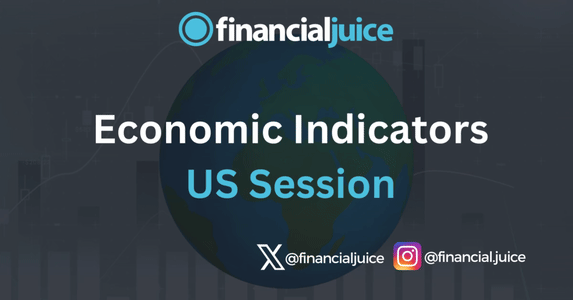
Week Ahead: Economic Indicators (US)
Hey, Traders!
For the January 22nd week, here is a list of all of the major economic indicators being released during the US Session, with a brief synopsis of what they represent and what to possibly expect from the markets in reaction.
Tuesday 23rd January
10:00 ET
Eurozone Consumer Confidence
Eurozone Consumer Confidence is an economic indicator that measures the sentiment and outlook of consumers in the Eurozone regarding economic conditions.
Published by the European Commission, the Consumer Confidence Index is derived from surveys that assess consumers’ perceptions of their personal financial situations, expectations for the future, and the overall economic environment.
What to Expect
A positive Consumer Confidence reading indicates optimism, while a negative reading suggests pessimism.
Although it is unlikely to move the markets, higher consumer sentiment could cause an upside risk to inflation. On the other hand, it also indicates that the consumer is doing well in the face of high interest rates, reducing the risks of a recession
Wednesday 24th January
09:45 ET
Bank of Canada Interest Rate Decision
First time released at it’s new scheduled time (Used to release at 10:00 ET)
The Bank of Canada Interest Rate Decision is the main monetary policy tool where the Bank of Canada’s Governing Council determines the official interest rate for the Canadian economy.
This rate, known as the overnight rate, influences short-term interest rates and serves as a key benchmark for borrowing costs in the country.
What to Expect
The Bank of Canada uses this rate to achieve its inflation target and support overall economic goals. Changes in the interest rate can impact consumer spending, business investments, and inflation.
It is widely expected that the BoC will leave rates unchanged at 5% for the fourth consecutive meeting.
If realized, attention will turn to the subsequent BoC rate statement for any clues on the future path of BoC interest rates.
Any mention of more rate cuts this year than are already priced in by the markets could prompt strength in Canadian stocks and weakness in the Canadian dollar.
However, hawkish remarks implying fewer interest rate cuts than are currently priced this year could result in the opposite.
US S&P Manufacturing & Services PMI
The US S&P Manufacturing and Services Purchasing Managers’ Index are economic indicators that measure the health of the manufacturing and services sectors, respectively.
These PMI indices are based on surveys of purchasing managers in these sectors and provide insights into business conditions, new orders, employment, and other key indicators.
As a diffusion index, a PMI reading above 50 generally indicates expansion, while below 50 suggests contraction.
The Manufacturing PMI focuses on the production of goods, while the Services PMI reflects activity in the services sector.
What to Expect
These indicators are monitored for an assessment of economic performance and potential trends.
Manufacturing has been in contraction for some time, while services have remained in expansion throughout the tightening cycle.
The Fed has noted that the services sector is proving to be a risk to sticky inflation. So a lower-than-expected, or lower than 50, reading on the headline services PMI could reinforce bets for more Fed rate cuts this year, causing potential strength in US stocks and weakness in the dollar.
However, it is worth realizing that there is a risk of a mixed batch of data between the Manufacturing and Services PMIs causing volatility.
10:30 ET
US Weekly Crude Oil Inventories
The US Weekly Crude Oil Inventories report provides information on the nation’s stockpile of crude oil, indicating changes in inventory levels over the previous week.
Published by the US Energy Information Administration, this report is crucial for understanding supply and demand dynamics in the oil market.
Fluctuations in crude oil inventories can influence oil prices and offer insights into market trends.
What to Expect
An increase in inventories may suggest oversupply or weaker demand, while a decrease may indicate stronger demand or disruptions in supply.
Thursday 25th January
08:15 ET
ECB Interest Rate Decision
The European Central Bank Interest Rate Decision is the ECB’s main monetary policy tool, where the ECB Governing Council determines the official interest rates for the Eurozone.
The key interest rates include the Main Refinancing Rate, which influences short-term interest rates, and the Deposit Facility Rate, which affects overnight deposits.
The ECB uses these rates to control inflation and support economic goals.
An increase in interest rates may curb inflation but could slow economic growth, while a decrease may stimulate economic activity but could lead to higher inflation.
The decision is crucial for financial markets, businesses, and policymakers as it shapes borrowing costs and overall economic conditions within the Eurozone.
What to Expect
Markets broadly expect this meeting to show the third consecutive hold of the interest rate at 4.5%.
If realized, attention will turn to the subsequent ECB rate statement and press conference for any clues on the future path of ECB interest rates.
Any mention of more rate cuts this year than is already priced in by the markets could prompt strength in EU stocks and weakness in the Euro.
However, hawkish remarks implying fewer interest rate cuts than are currently priced this year could result in the opposite.
08:30 ET
US GDP
US Gross Domestic Product is a key economic indicator that measures the total value of all goods and services produced within the United States.
It serves as a comprehensive gauge of the country’s economic performance and is published by the Bureau of Economic Analysis (BEA) on a quarterly basis.
GDP includes consumer spending, business investments, government expenditures, and net exports (exports minus imports).
What to Expect
Changes in GDP growth rates reflect the overall health and direction of the US economy, influencing policy decisions and providing insights into economic trends.
In terms of the market’s potential reaction to this data point, this is tricky to gauge at the current stage of the economic cycle.
On one hand, a higher-than-expected GDP can be seen as an upside inflation risk, as it can indicate increased demand through increased consumer and government expenditures.
On the other hand, inflation is coming down towards the target despite resilient consumer demand, so a higher GDP number could also reinforce the chances for a soft landing, with inflation still returning to the target.
Weekly Initial & Continued Jobless Claims
Initial Jobless Claims, released by the US Department of Labor, indicates the number of individuals filing for unemployment benefits for the first time. It serves as a real-time measure of layoffs and reflects the current state of the job market.
Continued Jobless Claims represent the number of individuals who continue to receive unemployment benefits. It offers a snapshot of ongoing unemployment trends and the duration of joblessness.
What to Expect
Both indicators gauge labor market dynamics, trends in unemployment, and overall economic health.
A decrease in initial and continued claims suggests an improving job market, while an increase may indicate economic challenges or contraction.
As a weekly release, it is unlikely to move the markets on its own, especially when it is paired with the release of US GDP as it is this week, which is likely to steal investor attention.
Having said that, the Fed has stated that inflation does seem to be coming down towards the target without a meaningful drop in unemployment. If it were to come out considerably higher than expected, this could be seen as an upside risk to inflation, otherwise, a strong labor market supports the Fed’s dual mandate and increases the chances of a soft landing for the US economy.
10:00 ET
US New Home Sales
US New Home Sales is an economic indicator that measures the number of newly constructed homes sold during a specific time period.
Published by the US Census Bureau, this data provides insights into the demand for newly built homes, reflecting trends in the housing market.
What to Expect
Increasing new home sales may suggest positive economic conditions, while a decline may indicate challenges in the housing sector.
This release is unlikely to move the market on its own, absent a large deviation from expectations.
Having said that, if the release shows higher-than-expected New Home sales, analysts will contend with the potential inflationary pressures caused by increased consumer demand, as well as the increased chance of a soft landing for the economy powered by a resilient consumer.
Friday 26th January
08:30 ET
US PCE Price Index
The US Personal Consumption Expenditures Price Index is a measure of inflation that gauges the average change in prices consumers pay for goods and services over time.
Published by the Bureau of Economic Analysis (BEA), the PCE Price Index is considered a key indicator of inflationary trends in the economy.
It is based on personal consumption expenditures, reflecting how households allocate their spending across various categories.
While similar to the Consumer Price Index (CPI), the PCE has some methodological differences, including the treatment of healthcare and the inclusion of a broader range of expenditures. Most importantly, unlike CPI, it does not monitor a fixed basket of goods in every report and makes adjustments for the goods and services that are tracked based on consumer spending habits during the reporting period.
The ‘Core’ PCE Price Index is the Fed’s preferred gauge of inflation, stripping out volatile food and energy components.
What to Expect
If PCE comes in higher than expected, this would be likely to cause markets to bet on less interest rate cuts this year.
This repricing could cause weakness in US stocks, and strength in the Dollar and US Treasury yields




